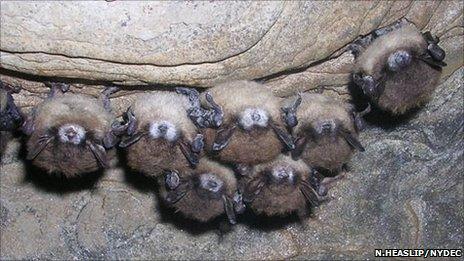US publishes white-nose bat killer action plan
- Published

Experts fear that if the spread of WNS continues unabated, some species will be wiped out in less than two decades
US experts have published an action plan that aims to halt the spread of white-nose syndrome (WNS), which has killed more than a million bats.
The document offers guidance on a range of issues, external, including how to identify the disease and improving bio-security.
WNS has spread rapidly since it was first found in 2006, and now affects 18 states and four Canadian provinces.
The action plan was unveiled at the fourth annual WNS conference in Arkansas, which runs until Thursday.
'Swift effort'
The US Fish and Wildlife Service, which led the formulation of the plan, said that the mobility of bats, the rapid spread of WNS, the potential for human-assisted transmission and the severity of the disease for infected animals meant that it was necessary for a "swift national effort to avoid irreversible losses to bat populations".
Jeremy Coleman, national white-nose syndrome co-ordinator for the US Fish and Wildlife Service, said it was vital to bring all the relevant groups - from government agencies to research institutions - together.
"Without a formal structure, it is very difficult for a lot of the agencies to be able to engage in a meaningful way," he told BBC News.
"It gives us all a common language, allowing us to compare information and come up with strategies that can be implemented throughout the continent, such as surveillance, monitoring bat populations and the collection of data."
While acknowledging that it was still early in the process, Dr Coleman said that such a structure was essential if there was any hope to tackle such a virulent disease that had spread so rapidly.
He also said that it was hoped that the plan would become an international blueprint in the not-too-distant future by including groups from Canada and Mexico.
Recent studies have painted a bleak picture for at least half of US bat species, which rely on hibernation for winter survival and are therefore potentially susceptible to the disease.
Writing in the journal Science in August 2010, a team of researchers warned some species' populations could become locally extinct within two decades, external.
And in April, another team estimated the loss of bat species, which help control pest populations, would cost US agriculture more than $3.7bn a year, external.
WNS has been described by some biologists as the worst wildlife health crisis in the US in living memory, is named after a white fungus that appears on the muzzle and/or wings of infected animals.
However, bats with WNS do not always have the characteristic visual symptoms, but may display abnormal behaviour around their hibernacula (caves and mines where bats hibernate during winter months).
These behaviours include flying outside during the day (when their insect prey is not available) in sub-zero temperatures, or clustering near the entrance to the hibernaculum.
Researchers say the fungus associated with the disease, Geomyces destructans, thrives in the dark, damp conditions - such as caves and mines.
Descent into darkness: Biologist Carl Herzog heads into an abandoned mine to assess the damage of the killer disease
It is believed that the fungus associated with WNS arrived in the US after it was somehow transported (probably via humans) from Europe or possibly Asia.
A team of European researchers followed up unconfirmed reports in Europe that bats had white fungal growths appearing to match the symptoms of WNS.
In a paper in the Emerging Infectious Diseases journal, they suggested that the Geomyces destructans fungus was present throughout Europe, external.
However, they added, it seemed as if species of bats in Europe were possibly more immunologically or behaviourally resistant to the fungus than North American species, as it did not increase mortality.
More than 150 of the world's leading bat experts are currently attending the fourth annual white-nose syndrome symposium, being held in Little Rock, Arkansas, until 19 May.
- Published24 December 2010
- Published6 August 2010